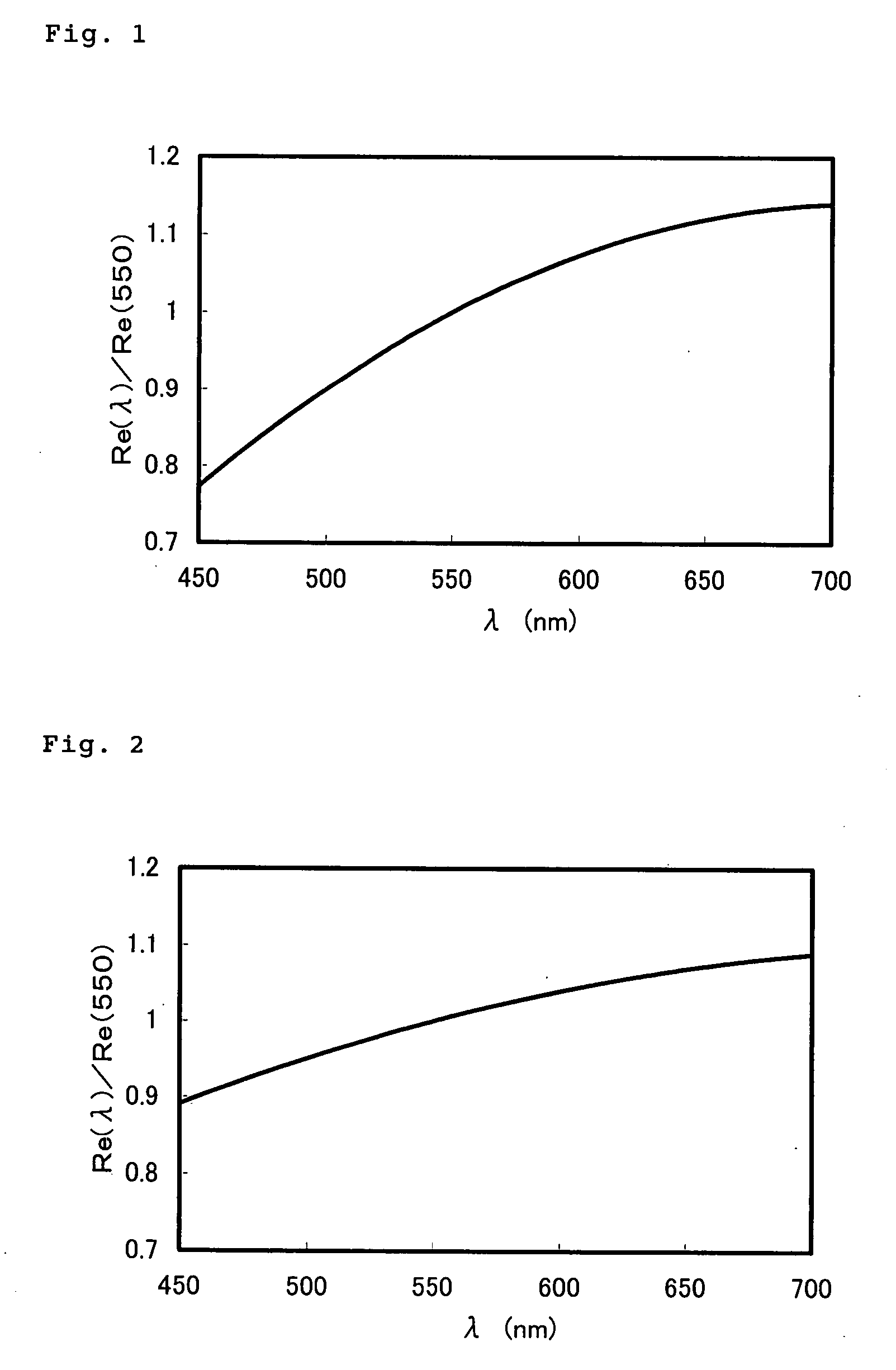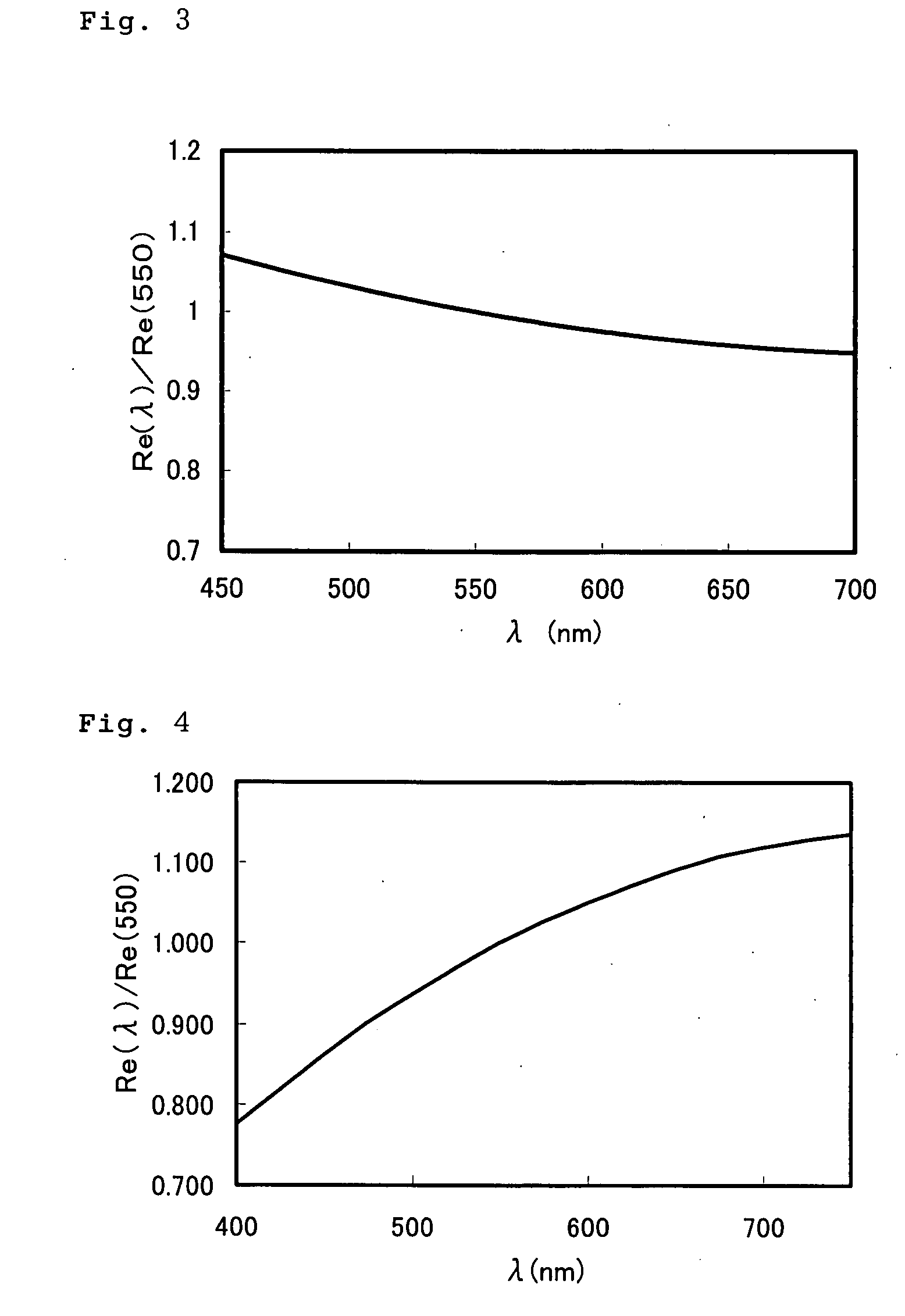Optical Film
a technology of optical film and polarizing element, applied in the field of optical film, can solve the problems of phase separation, increased haze, and difficulty in simply controlling the wavelength dispersion property
- Summary
- Abstract
- Description
- Claims
- Application Information
AI Technical Summary
Benefits of technology
Problems solved by technology
Method used
Image
Examples
example 1
Synthesis Example 1
Synthesis of Polymerizable Compound (1-1)
(Synthesis Examples of ethyl 4-(6-hydroxyhexyloxy)benzoate (a))
[0139] 150 g (0.90 mol) of ethyl 4-hydroxybenzoate, 186 g (1.35 mol) of potassium carbonate and 750 g of N,N-dimethylacetamide were weighed, and heated up to 80° C. Subsequently, 244 g (1.24 mol) of 6-bromohexanol was dropped over 2 hours, then, the mixture was stirred for 2 hours at 80° C. After cooling, the reaction liquid was poured into ice water, and extracted with ethyl acetate. The ethyl acetate phase was washed with water, then, the solvent was distilled off under reduced pressure to obtain 312 g of white solid containing ethyl 4-(6-hydroxyhexyloxy)benzoate (a) as the main component. As a result of analysis, (a) was obtained approximately quantitatively.
Synthesis Example of 4-(6-hydroxyhexyloxy)benzoic acid (b)
[0140] 312 g of white solid obtained above containing (a) as the main component was dissolved in methanol. Subsequently, a methanol solution ...
production example 1
of Optical Film
[0146] On a glass base plate, a polyimide alignment layer (SE-5291, manufactured by Nissan Chemical Industries, Ltd.) was applied, then, dried and annealed to obtain a membrane having a thickness of 138 nm. Subsequently, a rubbing treatment was performed, then, on the rubbing-treated surface, application liquid having a formulation in Table 5 was applied by a spin coat method, and dried for 1 minute at 55° C. The resultant un-polymerized film was observed by a polarization microscope to confirm mono-domain. Subsequently, irradiation with ultraviolet ray was carried out to obtain an optical film having a thickness of 1.5 μm.
TABLE 5Formulation of application liquidComponentwt %Polymerizable compound (1-1)10Rod-shaped polymerizable liquid crystal compound (3-3)10Photo-polymerizable initiator *12.5Leveling agent0.5Propylene glycol monomethyl ether acetate77
*1: Irgacure 907 (manufactured by Ciba Specialty Chemicals) (Measurement of wavelength dispersion property)
[0147] ...
example 2
Production Example 2 of Optical Film
[0150] An optical film was produced in the same manner as in Example 1 (Production Example 1 of optical film) excepting the use of application liquid in Table 6.
[0151] The wavelength dispersion from 450 nm to 700 nm of the resulting optical film was measured in the same manner as in Example 1, and the result is shown in FIG. 2. [Re(450) / Re(550)] was 0.89 and [Re(650) / Re(550)) was 1.07.
TABLE 6Formulation of application liquidComponentwt %Polymerizable compound (1-1)6.67Rod-shaped polymerizable liquid crystal compound (3-3)13.33Photo-polymerizable initiator *12.5Leveling agent0.5Propylene glycol monomethyl ether acetate77
*1: Irgacure 907 (manufactured by Ciba Specialty Chemicals)
PUM
| Property | Measurement | Unit |
|---|---|---|
| thickness | aaaaa | aaaaa |
| thickness | aaaaa | aaaaa |
| wavelength | aaaaa | aaaaa |
Abstract
Description
Claims
Application Information
 Login to View More
Login to View More - R&D
- Intellectual Property
- Life Sciences
- Materials
- Tech Scout
- Unparalleled Data Quality
- Higher Quality Content
- 60% Fewer Hallucinations
Browse by: Latest US Patents, China's latest patents, Technical Efficacy Thesaurus, Application Domain, Technology Topic, Popular Technical Reports.
© 2025 PatSnap. All rights reserved.Legal|Privacy policy|Modern Slavery Act Transparency Statement|Sitemap|About US| Contact US: help@patsnap.com



